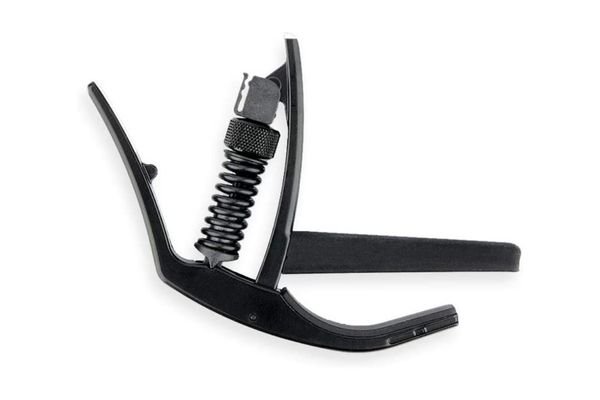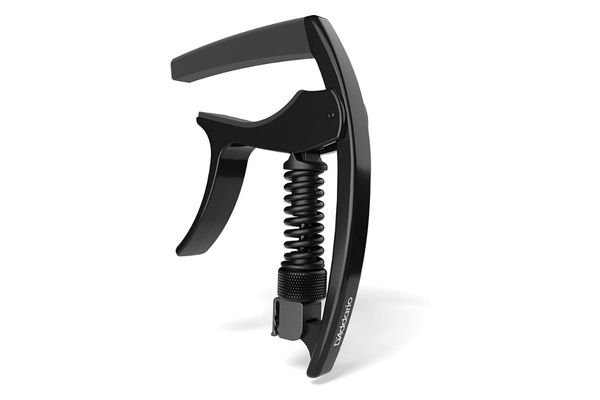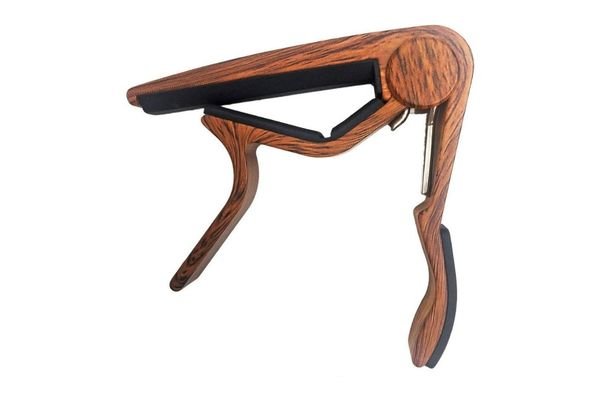A quality capo lets you maintain proper intonation, quickly adjust keys for complex passages and even find the sweet spot without muffling or distorting sound on every instrument, including classical guitars. So, you can get your hands on the best of them; I’ve compiled a list of the 7 best capos for classical guitar based on material, the sound quality when used, and adjustment.
See Also: 5 Best Classical Guitar Case
To my finding, G7th Performance 3 Capo is the overall best capo for its ease of use and high-quality materials and fits most fretboards. But if you have a flat fretboard, the NS Artist Classical Capo by D’Addario is the better choice with micrometer adjustment, silicone padding, and a smooth playing experience. Without any further ado, let’s get down to a detailed review of the best capos.
- List of best capo for classical guitar
- 1. G7th Performance 3 Capo with ART (Best Overall)
- 2. NS Artist Classical Capo by D'Addario (Best Lightweight)
- 3. D’Addario Guitar Capo
- 4. Guitar Capo Deluxe for Guitars (Best Look & Feel)
- 5. Shubb Guitar Capo (S1) (Best Vintage Look)
- 6. WINGO Classical Flat Guitar Capo (Best Budget)
- 7. Kyser Quick-Change Guitar Capo For Classical Guitars
- How to Choose the Best Capo For Classical Guitar?
- Final Words
List of best capo for classical guitar
1. G7th Performance 3 Capo with ART (Best Overall)
Key Features
- Material: Steel, Nylon
- Item Weight: 1.6 ounces
- Product Dimensions: 2.5 x 2.75 x 0.59 inches
G7th Performance 3 Capo is the upgraded version of the previous two Performance capos. The brand introduced the latest version, Performance 3, which features a similarly polished and high-quality finish; the key difference is that it stands in between the forerunners in size. It’s a premium steel-made capo for classical, flamenco, and nylon string guitars. With advanced radius technology (ART), it fits the curvature of any neck, ensuring optimal intonation and tuning stability. I’ve tested it on two of my Taylors (214ce and 814ce), and it worked well on both. This capo features a button for easy clamping and releases to adjust quickly. Its pockets are made of silicone rubber to protect your instrument from scratches or damage to the finish and reduce vibration damping.
Pros
- Great tuning stability
- Sleek and futuristic design
- Quality locking mechanism
- One hand operation
- Easy to fit
- Lifetime warranty
Cons
- Expensive
2. NS Artist Classical Capo by D’Addario (Best Lightweight)
Key Features
- Material: Aluminum
- Item Weight: 0.16 ounces
- Product Dimensions: 5.5 x 0.13 x 7 inches
High-quality aluminum-built NS Artist Capo is durable, easily adjustable, and at the same time, super lightweight (only 0.01 pounds!). Although it’s designed for classical guitars (flat fretboards), it also fits acoustic and electric guitars. I tried it on my late 70’s Yamaha GS55A classical guitar with a wide flat fretboard, and it worked fantastically! The flexibility of NS Artist’s adjustable spring allows you to reposition and move it around easily. On top of it, the micro-meter adjustment lets you fine-tune the tension to suit your instrument perfectly. And let’s not forget about the high-quality silicone padding – your instrument is safe from scratches and damage.
Pros
- Comes with a tuner attachment
- Integrated pick holder
- Quality locking mechanism
- One hand operation
- Easy adjustment
- Versatility
Cons
- Expensive
3. D’Addario Guitar Capo
Key Features
- Material: Aluminum
- Item Weight: 0.288 ounces
- Product Dimensions: 5.9 x 0.4 x 7 inches
Another capo from D’Addario that ensures accurate and consistent pressure across all strings on any fret. I didn’t find any fret buzz even when playing complex chords, and the intonation was over the moon! Additionally, the micrometer tension adjustment allows you to adjust it to your preference. The aluminum construction makes it easy on the fretboard (flat), and the spring-loaded mechanism allows for quick and effortless placement. On top of it, the capo’s padded contact points protect your instrument’s neck and fretboard from scratches and dents.
Pros
- One hand easy use
- Easy adjustment
- Micrometre locking mechanism
- Lightweight
- Even pressure across all strings
- Integrated pick holder
Cons
- The pin is weak
4. Guitar Capo Deluxe for Guitars (Best Look & Feel)
Key Features
- Material: Silicone, zinc alloy
- Item Weight: 1.6 ounces
- Product Dimensions: 4 x 3.5 x 0.5 inches
This capo is made with a quick-release steel mechanism and premium zinc. It comes with a handy instruction manual and a convenient storage pouch. While the price may be on par with other top brands like D’Addario and Shubb, the quality and luxurious aesthetic of the capo make it well worth the investment. With a smooth spring locking mechanism, the capo is suitable for any 6 and 12-string instruments, and it worked just fine on Fender 12-string acoustic-electric guitar when tried. The high-quality silicone padding of the capo ensures that your instrument will be well-protected while maintaining excellent intonation.
Pros
- Quick release
- Easy adjustment
- Effective locking mechanism
- Luxurious finish
- Lifetime warranty
Cons
- A bit heavy
5. Shubb Guitar Capo (S1) (Best Vintage Look)
Key Features
- Material: Stainless steel
- Item Weight: 0.01 ounces
- Product Dimensions: 5.5 x 3 x 0.25 inches
Whether you’re strumming on classical or acoustic guitar, the Shubb S1 capo has fully adjustable tension that ensures a clean and clear sound every time. With the micrometer adjusted, you can use it on classical, electric, and acoustic guitars. The roller locking mechanism and the stainless-steel construction are a bit old school, but the capo’s rubber grip is excellent on the fretboard (radius). It worked fantastic on Martin D12-28, no buzz! This capo allows quick change of keys, and you don’t need to reset the pressure after each use.
Pros
- Easy adjustment
- Sturdy construction
- Quality locking mechanism
- Vintage look
- Quality padding
Cons
- It needs two hands to put on
6. WINGO Classical Flat Guitar Capo (Best Budget)
Key Features
- Material: Wood, aluminum alloy
- Item Weight: 1.44 ounces
- Product Dimensions: 4.09 x 3.35 x 0.75 inches
Explicitly designed for nylon string guitars, this capo features an aluminum alloy spring with a quick-release mechanism. The WINGO capo is easy to clamp; put it on the 10th fret without any trouble. The silicone padding of the capo ensures that it won’t damage your guitar’s fingerboard (flat), and the Rosewood finishes on the wooden construction adds a touch of elegance. While it may not have the same longevity as more expensive models, it’s hard to beat at this price point. Plus, it comes with five picks to sweeten the deal!
Pros
- Low cost
- Quality locking mechanism
- One hand operation
- Sturdy spring
- Extended padding fits the fret perfectly
Cons
- A bit tough to put on
7. Kyser Quick-Change Guitar Capo For Classical Guitars
Key Features
- Material: Aluminum, steel
- Item Weight: 2.40 ounces
- Product Dimensions: 6.8 x 4.5 x 0.7 inches
Kyser Quick-Change allows you to easily change the pitch of your instrument without re-tuning it. The capo is lightweight aluminum and fits well even on flamenco guitars with nylon strings (flat fretboards). It will fit over all the strings on any wide-neck classical guitar. You can easily store the capo on your instrument’s headstock when not in use. This spring-loaded capo may not come with advanced features, but with the plain and simple design, it gets the job done.
Pros
- One hand easy use
- No adjustment is required to use
- Lightweight and compact
- Lifetime guarantee
Cons
- Not-so-sturdy construction
How to Choose the Best Capo For Classical Guitar?
1. Consider The Type of Capo:
There are mainly two types of classical capo: spring-loaded and screw-on. Spring-loaded capos are great for beginners or anyone who wants a quick and easy way to change keys. On the other hand, screw-on capos are an excellent choice for anyone who wants to avoid damaging the guitar finish. So, choose the type that best fits your needs.
Why Should You Consider the Type Of A Capo?
The type of capo you use can affect your guitar’s tone, pitch, and overall sound. Spring-loaded capos are great for their convenience and affordability, but with them, you won’t get the high precision and control of a screw-on capo. So, the type of capo you need depends on your personal preference, and it affects your overall playing.
2. Build Material:
Capos are made from plastic, metal, aluminum, or a combination of materials. If you prefer durability, you should go for metal capos, while aluminum capos have better padding to protect your fretboard and its finish.
Why Should You Consider the Build Material of A Capo?
The material of a capo matters because it can affect its sound, durability, and performance. A capo of heavier materials like brass or steel may offer a more solid grip but can also alter the guitar’s tone. But a capo made of lightweight materials, like aluminum, won’t add too much weight or affect the tonal quality of your instrument.
3. Adjustable Tension:
Too much pressure can cause strings to break, while too little pressure can result in buzzing or muted strings. Look for a capo that has adjustable tension.
Why Is Adjustable Tension In A Capo Important?
Adjustable tension in a capo is crucial because it allows you to customize the pressure on the strings, let you play better sound, and enhance playability. Adjustable tension will allow you to find the sweet spot that works for your playing style.
4. Check If The Capo Fits:
Make sure the capo fits your guitar properly. Some capos are explicitly designed for flat fretboards, while others are meant for radius fretboards. Some capos are suitable for both flat and radius fretboards. So, don’t buy a flat fretboard type capo for your radius fretboard.
Why Should You Care About The Fit?
The capo’s curvature affects the pressure it puts on the strings. With a flat capo, the pressure will be evenly distributed across all the strings, giving you a consistent sound. In contrast, a radius capo will apply more pressure to the strings at the center of the fretboard and less stress toward the edges. So, using a flat capo on a curved fretboard guitar (like a Gibson or Martin) may be harder to play and control your guitar.
Final Words
Whether you prefer a sleek and minimalist design or a more ornate and eye-catching capo, there’s a perfect fit in my list of best capo for classical guitar. Whether you’re looking to transpose a song into a different key, play in an alternate tuning, or simply add some new colors to your sound, a quality capo can help you achieve that.







